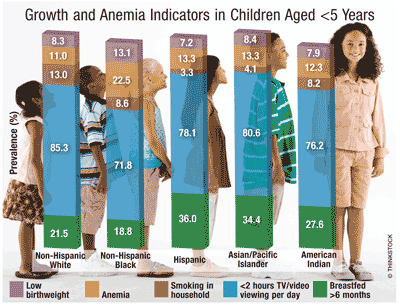US Pharm. 2014;39(5):7.
Data on key health indicators in children, such as birthweight, breastfeeding, television viewing, smoking, and anemia, were collected by the 2010 Pediatric Nutrition Surveillance System.

Low Birthweight: Although the infant mortality rate fell from 26 to seven per 1,000 live births between 1996 and 1999, low-birthweight (LBW) infants (<2,500 g) were 40 times more likely than normal-birthweight infants to die during the first 4 weeks of life. The overall prevalence of LBW births, which remained stable at 9% from 2001 through 2010, was higher in black infants (13.2%) than in white (8.5%), Asian/Pacific Islander (8.9%), American Indian (8.2%), and Hispanic (7.1%) infants.
Breastfeeding: Between 2001 and 2010, there was a 13.1% increase in breastfeeding initiation, with prevalence across all ethnic groups. In 2010, 10.7% of infants were exclusively breastfed for ≥3 months. About 63% of infants were ever breastfed, and 25.1% were breastfed for ≥6 months. The proportion of infants breastfed for ≥6 months increased from 21.5% (2001) to 25.1% (2010). The increase occurred across all ethnic groups, with Hispanic infants at 35.1% (highest) and black infants at 18% (lowest).
Television Viewing: In 2010, 79.2% of children aged 2 to 4 years viewed ≤2 hours of television daily. The proportion of children meeting this American Academy of Pediatrics recommendation was lowest among black (69.9%) and American Indian or Alaska Native children (77.6%) and highest among white children (85.1%).
Household Smoking: In 2010, 9.4% of children were exposed to household smoke. Exposure was highest in white (17%) and black children (9.5%) and lowest in Asian/Pacific Islander children (4.2%). Exposure in children aged <1 year was lower (8.5%) than in those aged 0 to 4 years (9.4%). Women who smoked during the first and second trimesters had a 70% increased risk of delivering an LBW infant, versus a 30% increased risk in women who smoked during the first trimester only.
Anemia: Despite increased administration of iron to infants over the last 50 years, 14.6% of children were anemic, with the highest prevalence in those aged 6 to 23 months (18.1%) and those aged 12 to 17 months (18.2%). The lowest prevalence was in children aged 3 to 4 years (10.6%). The overall prevalence of anemia increased slightly, from 13.4% in 2001 to 14.6% in 2010. During this period, the overall prevalence of anemia dropped to 13% in 2002, but increased subsequently. In 2010, the highest prevalence was in black children (22.5%), and the lowest prevalence was in white children (11.2%). From 2001 through 2010, the largest increase was in black children (2.9%). The prevalence declined slightly among Asian/Pacific Islander children.
To comment on this article, contact rdavidson@uspharmacist.com.





